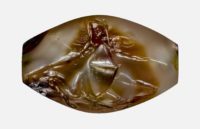 Found in a previously unexplored field near the Palace of Nestor in Pylos in 2015, the richly furnished shaft tomb of a Mycenaean warrior was filled with precious artifacts of unprecedented quantity and quality, more than 3,000 objects including gilded weapons, gold rings, a massive gold chain, thousands of semi-precious stone beads, seal stones and between his legs, an ivory plaque engraved with a griffin on a rocky landscape. Two years later one tiny agate sealstone of Cretan manufacture emerged from its thick lime accretion to reveal itself as one of the greatest masterpieces in ancient Greek art, far more advanced in craftsmanship than anybody realized the Minoans were capable of in 1,500 B.C.
Found in a previously unexplored field near the Palace of Nestor in Pylos in 2015, the richly furnished shaft tomb of a Mycenaean warrior was filled with precious artifacts of unprecedented quantity and quality, more than 3,000 objects including gilded weapons, gold rings, a massive gold chain, thousands of semi-precious stone beads, seal stones and between his legs, an ivory plaque engraved with a griffin on a rocky landscape. Two years later one tiny agate sealstone of Cretan manufacture emerged from its thick lime accretion to reveal itself as one of the greatest masterpieces in ancient Greek art, far more advanced in craftsmanship than anybody realized the Minoans were capable of in 1,500 B.C.
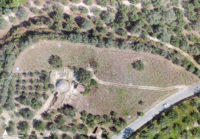 The discovery of the richest tomb ever found in ancient Greece, dubbed the Griffin Warrior tomb after the extraordinary ivory plaque, made headlines all over the world. It put a global spotlight on the archaeological motherlode at Pylos. Excavating the land immediately to the east of the Griffin Warrior tomb, the University of Cincinnati archaeology team who made the sensational find in 2015 have now discovered another two elite Bronze Age tombs replete with grave goods.
The discovery of the richest tomb ever found in ancient Greece, dubbed the Griffin Warrior tomb after the extraordinary ivory plaque, made headlines all over the world. It put a global spotlight on the archaeological motherlode at Pylos. Excavating the land immediately to the east of the Griffin Warrior tomb, the University of Cincinnati archaeology team who made the sensational find in 2015 have now discovered another two elite Bronze Age tombs replete with grave goods.
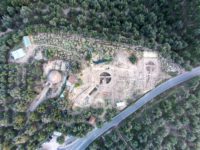 This excavation was a long time in coming. The plot is privately owned. University of Cincinnati archaeologist Carl Blegen, who discovered the Palace of Nestor in 1939, unearthed an important beehive grave right at the edge of the property in the 1950s and asked the owner for permission to excavate the site but was denied. More than six decades would pass before Greek authorities were able to get access to the property and give another University of Cincinnati team the chance to fulfill Blegen’s goal.
This excavation was a long time in coming. The plot is privately owned. University of Cincinnati archaeologist Carl Blegen, who discovered the Palace of Nestor in 1939, unearthed an important beehive grave right at the edge of the property in the 1950s and asked the owner for permission to excavate the site but was denied. More than six decades would pass before Greek authorities were able to get access to the property and give another University of Cincinnati team the chance to fulfill Blegen’s goal.
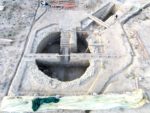 Excavations began in 2018. Due to the delays in securing the site for excavation, the team was not able to perform a ground-penetrating radar scan that would give them hard data on where to dig. Instead, archaeologists used landscape features to determine where to dig. Once the currant plants covering the land were removed, large concentrations of stones (an estimated 40,000 of them) and several large slabs on the southeast of the parcel indicated to archaeologists there might be something worth pursuing.
Excavations began in 2018. Due to the delays in securing the site for excavation, the team was not able to perform a ground-penetrating radar scan that would give them hard data on where to dig. Instead, archaeologists used landscape features to determine where to dig. Once the currant plants covering the land were removed, large concentrations of stones (an estimated 40,000 of them) and several large slabs on the southeast of the parcel indicated to archaeologists there might be something worth pursuing.
 They were right. By the end of May, the team had discovered two previously unknown beehive-shaped vaulted tombs. Tholos VI and VII are the same type as the tomb discovered by Blagen 63 years earlier and the entrance passages of the three tombs are parallel to each other. This was a ceremonially important burial ground along the road from the Palace of Nestor to Chora, not a tomb or two placed on a prime hilltop real estate.
They were right. By the end of May, the team had discovered two previously unknown beehive-shaped vaulted tombs. Tholos VI and VII are the same type as the tomb discovered by Blagen 63 years earlier and the entrance passages of the three tombs are parallel to each other. This was a ceremonially important burial ground along the road from the Palace of Nestor to Chora, not a tomb or two placed on a prime hilltop real estate.
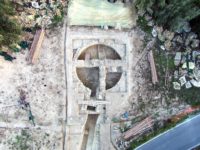 The vaults of both tombs had collapsed (that’s where all the stones came from) and tons of soil and rock had fallen in to the space. Nonetheless, there are clear archaeological strata inside the chambers. Tholos VI has a large chamber 40 feet in diameter and walls reaching 15 feet above the tomb floor. Tholos VII is smaller, 28 feet in diameter with surviving walls rising six-and-a-half feet above the floor. Carved stones were found on the floor of Tholos VI that cannot have fallen from the vault. They were likely recycled from the Palace of Nestor.
The vaults of both tombs had collapsed (that’s where all the stones came from) and tons of soil and rock had fallen in to the space. Nonetheless, there are clear archaeological strata inside the chambers. Tholos VI has a large chamber 40 feet in diameter and walls reaching 15 feet above the tomb floor. Tholos VII is smaller, 28 feet in diameter with surviving walls rising six-and-a-half feet above the floor. Carved stones were found on the floor of Tholos VI that cannot have fallen from the vault. They were likely recycled from the Palace of Nestor.
 The tombs were replete with artifacts and jewelry — Baltic amber, Egyptian amethyst, carnelian, gold. Flakes of gold leaf, now crumbled, had once adorned the rough stone of the walls. These expensive imports attest to Bronze Age Pylos’ extensive trade links, despite its remote location. The tombs can only have belonged to the Mycenaean elite, likely aristocracy.
The tombs were replete with artifacts and jewelry — Baltic amber, Egyptian amethyst, carnelian, gold. Flakes of gold leaf, now crumbled, had once adorned the rough stone of the walls. These expensive imports attest to Bronze Age Pylos’ extensive trade links, despite its remote location. The tombs can only have belonged to the Mycenaean elite, likely aristocracy.
Artifacts found in the princely tombs tell similar stories about life along the Mediterranean 3,500 years ago, Davis said. A gold ring depicted two bulls flanked by sheaves of grain, identified as barley by a paleobotanist who consulted on the project.
“It’s an interesting scene of animal husbandry — cattle mixed with grain production. It’s the foundation of agriculture,” Davis said. “As far as we know, it’s the only representation of grain in the art of Crete or Minoan civilization.”
Like the grave of the Griffin Warrior, the two family tombs contained artwork emblazoned with mythological creatures. An agate sealstone featured two lion-like creatures called genii standing upright on clawed feet. They carry a serving vase and an incense burner, a tribute for the altar before them featuring a sprouting sapling between horns of consecration, Stocker said.
Above the genii is a 16-pointed star. The same 16-pointed star also appears on a bronze and gold artifact in the grave, she said.
“It’s rare. There aren’t many 16-pointed stars in Mycenaean iconography. The fact that we have two objects with 16 points in two different media (agate and gold) is noteworthy,” Stocker said.
The genius motif appears elsewhere in the East during this period, she said.
“One problem is we don’t have any writing from the Minoan or Mycenaean time that talks of their religion or explains the importance of their symbols,” Stocker said.
UC’s team also found a gold pendant featuring the likeness of the Egyptian goddess Hathor.
“Its discovery is particularly interesting in light of the role she played in Egypt as protectress of the dead,” Davis said.
Excavations will continue for at least another two years, and documentation and conservation of the huge number of artifacts will take even longer.